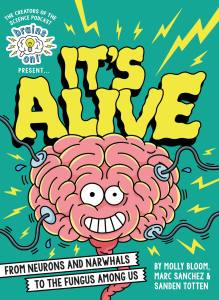Molly Bloom, Marc Sanchez, & Sanden Totten on BRAINS ON!
 If you’ve hung with a kid before, or were a kid yourself, you know how cool kids’ brains are. They’re constantly learning, soaking up information like sponges. And the coolest part is that each new piece of knowledge does not extinguish the curiosity that led to it, but rather it feeds it, prompting more and more questions.
If you’ve hung with a kid before, or were a kid yourself, you know how cool kids’ brains are. They’re constantly learning, soaking up information like sponges. And the coolest part is that each new piece of knowledge does not extinguish the curiosity that led to it, but rather it feeds it, prompting more and more questions.
As the hosts of the American Public Media podcast Brains On!, we’ve had the privilege to help kids around the world answer the many burning questions that they send in to us—everything from “what’s at the edge of the universe?” to “why do feet smell?” Since 2013, the Brains On podcast has been a sandbox where we’ve been able to play and experiment and figure out the best ways to communicate complicated science concepts to young listeners. And now, with the publication of our first book, Brains On! Presents It’s Alive! From Neurons and Narwhals to the Fungus Among Us, we’re so excited to bring these lessons to our work for young readers as well.
Find a metaphor: Stories are the best way to grab someone’s attention, but how do you do that for complicated ideas like how our immune systems work or how pollen helps plants reproduce? Finding the right metaphor is key. For pollination, we described the genetic information present in pollen as a small important package that needs to be delivered from one flower to the next. But since there’s no pollen-postal service, flowers get creative! Instead of mail, they send their packages via bees or on the breeze. Anthropomorphizing is useful too! For the immune system, we invented a character called Leela Lymphocyte, a Marie Kondo-esque white blood cell who tidies up our bodies with the help of friendly virus-fighting cells. Hearing the immune system describe its work as if it was narrating a reality TV show about decluttering is both memorable and fun.
Jargon vs Vocab: It’s important to figure out what words you want kids to take away after they read, and which ones will just be distractions. Learning new words and recognizing them when you hear them out in the world can be empowering for kids. For example, when we described how the brain sends signals we wanted to make sure kids knew what neurons were, but we didn’t dive deeply into synapses, axons, the cerebral cortex, etc. Instead, we boiled the process down to “Zap, Squirt, Click”—the brain sends an electrical signal (zap!), the body releases chemicals (squirt!), which activate cells (click!). It’s a memorable way to learn how the brain sends signals without getting lost in extra terms that would make it harder to remember.
It’s ok not to know: Kids have no trouble telling you when they don’t understand something. This allows them to ask better questions and get better answers, and ultimately keep learning. We try to model this mentality in our episodes and in the book. We don’t shy away from questions that may not have complete answers. We may understand partially how something works, but we are quick to point out when scientists are still working to find out more. For instance, we understand what happens in our bodies when we have an allergic reaction, but not why some people have allergies and other people don’t. We model that science is a process—and that there are always more questions to ask and answers to find.
Instill wonder: When explaining how something works, it’s easy to forget that all this knowledge might be new to a kid. And that when you take a second to think about any of it, it’s really truly mind-blowing. Plant roots can send signals and absorb nutrients and water??? Bacteria make delicious foods possible??? Your body is full of electricity??? To hook kids and keep them reading, it’s important to give space for these kinds of realizations. They’ll wonder what amazing fact is on the next page—and they’ll take this wonder with them when they close the book and look at the world around them, too.
Right now, understanding science is more important than ever. Over the last several months, we’ve all gotten a crash course in coronavirus transmission and vaccine development. True to form, kids have plenty of questions. In fact, we partnered with the Science Museum of Minnesota in a National Science Foundation-funded research study to learn more about what kids and parents needed when it came to information about COVID-19. This research helped inform several episodes of our podcast about the coronavirus, where we directly answered listener questions about the science of viruses and vaccines, and the emotional impact as well. We heard from many parents that these episodes helped ease their youngsters’ worries about this pandemic. It turns out, like adults, kids feel safer and calmer when they understand what’s going on around them, even during difficult times.
That’s why this work is so important. We live in complex times, and there is a lot going on both globally and in our own backyards. We all have a role to play when it comes to helping educate the next generation. Our biggest piece of advice is a simple one: let kids be the guide. Encourage them to ask questions and go with them wherever the answers lead. With that simple formula we can create lifelong learners who will be ready to handle the problems of the 21st century.
Well hold on to your noggins, because you're about to find out!
Join the creators of the award-winning science podcast Brains On! as they explore the uber-awesome and sometimes gross world of biology—aka the study of living things. Inside these pages, you'll meet animals with superpowers, plants that eat meat, brains that trick you, and tiny microbes that live, well . . . all over you!
Packed with mind-boggling facts and laugh-out-loud jokes, this book promises a brain-bending, jaw-dropping, belly-laughing good time as readers watch the world around them come ALIVE.
